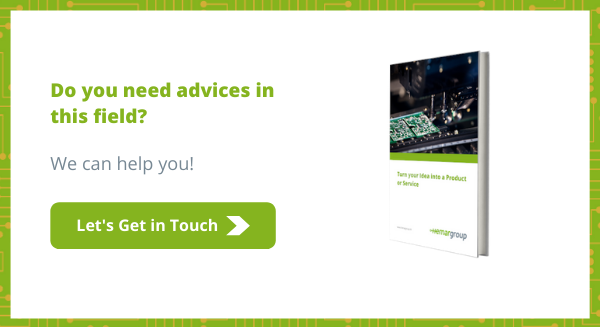
2018 will be a very peculiar year for the Internet of Things. In fact, the public and the experts still cannot find a common language to define this phenomenon, and for this reason, there are different opinions, from marketers on one side, and psychologists and sociologists on the other.
For experts and marketers,IoT is obviously a great opportunity to finally create a functional networking between industries and final customersWith an approximate forecast of c.a. 30.7 billion connected devices by 2020, according to IHS, and a market which will grow its investments, reaching $6 trillion, the Internet of Things is destined to become one of the most attractive markets in the upcoming decades. This not only applies to industries which offer services in this field, but also to markets which are not properly “digitalized”, and are finally starting to notice the benefits of investing in the development of an IoT device.
On the other hand, recent events and content we are exposed to on a daily basis make the totally opposite predictions. From the dystopian society depicted in the award-winning series Black Mirror where, due to the massive use of Big Data, the Internet of things becomes the Internet of People, to the recent case of Cambridge Analytica and Alibaba’s Sesame Credit; the IoT phenomenon seems very far reaching and more pervasive than ever.
In this article, we’ll discuss the highlights of these recent events, which are literally making the history of the Digital Transformation Era. We’ll highlight what exactly happened, why there is so much fuss around them, and mostly, what tech startups can learn from these cases, as well as why now is the best moment to invest in building IoT devices, because of these recent events.
Build an IoT device: what we’ve learned from the Cambridge Analytica case
The most recent event, in terms of data spreading and influencing the decision processes, is surely Cambridge Analytica; a British data analytics companyfirm which is in the eye of the storm, due to it misusing the personal data of more than 50 million Facebook users.
Now, you’re surely wondering what the connection between this case and the IoT phenomenon is. Let’s take a glance at what actually happened and find out why Cambridge Analytica completely changed the market of the Internet of Things.
It all started with a mobile application, “thisisyourdigitalife”, developed by Aleksandr Kogen, a Cambridge University researcher, whose first and main purpose was the research and psychological analysis of users. How? Collecting data based on users’ behavior and opinions about everyday life, demographic information, such as age and nationality. Like many apps, “thisisyourdigitalife” spread all over Facebook, meeting the excitement of oblivious and non-suspecting users. Actually, according to Facebook’s privacy and policy agreement at the time, there wasn’t any kind of misuse of this data. Until one day, Mr. Kogen decided to sell all the acquired information to the now well-known Cambridge Analytica, which used it for political purposes. We are talking about the personal information and profiles of more than 50 million people. A company whose motto is, “Data drives all we do. Cambridge Analytica uses data to change audience behavior.“, used that information to influence the decision-making process of thousands of voters, during the 2016 US presidential elections. How? By producing and spreading information, which actually affected the sensibility of a big part of that audience, influencing their vote during the elections.
It wasn’t even a one-off. The British based company has an extended portfolio of data-driven political outcomes and is not afraid to brag about it.
The point is that, as we’ve seen on different occasions, the main benefit of the interconnection provided by the Iot-strategy is the enormous amount of data that might be collected.
But after the Cambridge Analytica case, a lot has changed in the IoT scenario, especially for industries and startups which operate in the field or are interested in being part of it. So, if you are interested in building your first IoT prototype device, you should consider these highlights:
- As the pioneer of Internet rights, John Perry Barlow used to say “relying on the government to protect your privacy is like asking a peeping Tom to install your window blinds”. After the Cambridge Analytica case, a huge number of companies and industries operating in the IoT field will face a high demand, from customers in the first place, for data protection and privacy software solutions. This forecasts a long life for tech startups which will not only have to provide IoT solutions for sensible data protection for themselves, but will face also a high demand from the market, in that sense. This is one of the first reasons why now is the right time to invest in IoT devices, which, as we have already mentioned, might be cloud systems and software solutions, providing secure data storage.
- Cambridge Analytica is not the only case that showed us the power of data on influencing the consumers’ behavior, but it’s the most recent one. If we imagine this event in a different scenario, with the correct use of data, this could teach us a lot.
The power of data is undeniable today, more than ever, and it is fundamental for tech startups and other industries to possess all that information about potential customers to satisfy their needs and requirements. Investing in an IoT prototype today is not only an option but a must-have for tech industries wanting to break through in their field. Why? Imagine investing a lot of effort and time in the development of a new feature of your service, or a new product, without knowing anything about your audience. You might think that you’re doing great, but the reality is that you wouldn’t know what the actual requirements and needs of your potential customers are. So why take the risk? Why not cut the cost and invest in a device which can collect data and retrieve it for you, in order to find out what people actually need?
Why is the combo Alibaba & Sesame Credit IoT?
Alibaba and its Sesame Credit is another very particular case which is under criticism in China. Alibaba is a private company, founded in 1999 by Jack Ma, whose main aim is to connect foreign buyers to the Chinese market, through e-commerce, Artificial technology, and Tech solutions. It is considered one of the largest internet companies, operating globally. In 2011, Alibaba was classified by Forbes as among the 2000 most influential companies in the word.
One of the affiliates of the Alibaba group, Ant Financial Services group, launched a software called Sesame Credit. It’s basically a scoring system, through which customers are given a score based on their social media preferences and behavior, along with past purchases on Alibaba’s e-commerce portal. Basically, if you have a good score, you can receive benefits such as discounts and credit to use on Alibaba’s affiliated groups. If your score is not so good, because you purchase stuff which is “not properly valuable” for the system, you are “penalized” by not receiving any bonuses.
Now, remember when we talked about the dystopian future depicted by the series Black Mirror? In one of the episodes, people can evaluate each other, based on their appearance in terms of trustworthiness and likeness, and on the basis of that score, the “system” will decide if they can be qualified to obtain a loan or buy a car, for example.
So the Sesame software experiment may seem unappealing to Chinese consumers, but in different terms, it might be extremely useful for tech startups which are considering to invest in IoT devices, and here’s why:
- Through data collection, based on the customer’s past behavior, it’s possible to offer a “personalized” customer experience! According to Bain&Company “A 5% increase in customer retention can increase boost a company’s profitability by 75%”. The three “mantras” of Bain&Company are:
1. Repeat purchasers spend more and generate larger transactions.
2. Repeat customers refer more people and bring in more business.
3. Loyal customers will buy other products from you.
What’s the easiest way to achieve all three of them? By investing in an IoT prototype, which will help you track the behavior of your customers! In that way, you can make personalized offers and a customized experience for your clients.
The rise of the IoT era: manufacturing and logistics
We’ve already had a glance at the expected trends in the IoT industry, and one in particular, was the spreading of the Internet of Things within manufacturing and logistics.
In fact, according to IDC data, the manufacturing industry was the industry with highest proportion of spending on IoT solutions in 2016. Almost $102 billion US, from the total spending of $178 billion in IoT, followed by the other most profitable, vertical market in IoT, which is transportation.
The benefits for these two markets are huge, such as:
- customer-centricity
- monitoring the operation systems
- coordination of supply chains
- automation of the processes
And these are only a few. According to the Verizon’s report:
- 76% of companies operating in manufacturing consider IoT to be a fundamental factor in order to collect insights about customer behavior and increase customer satisfaction;
- 66% of these companies use IoT systems and prototypes to prevent risk and guarantee staff security;
- 60% improve the quality of the services and products because of the Internet of Things.
On the other side, according to this report, the forecasts about the IoT spread in logistics are:
- in 2017 in the EU, there were 33.1 million connected logistic units;
- in 2020 these units will become 55.5 million;
- in 2025 they will reach 99.5 million;
These predictions explain the huge demand for IoT devices and solutions in these two markets, which are pictured to be the most profitable ones in the IoT industry.
Therefore, whether you have a tech startup or you collaborate with the manufacturing industry or logistics, now is the best moment to invest in IoT devices, not only to increase your profits, but to also be part of the Digital Transformation a.k.a. Industry 4.0.
Start with having a look at our free checklist and discover what you need to know before developing your first IoT device.
.png)
